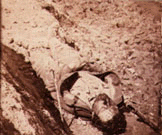

Although documentation of war began early in the history of photography, early war photographs do not show death.36 Instead, they show battlefields or military officers. There are a number of reasons for this. The earliest war photographers were amateurs, usually soldiers themselves. Their pictures were not meant for publication, and therefore show things of personal interest to them. Dead bodies were not of interest. The first professional photographer to make successful war pictures was the Englishman Roger Fenton, whose photographs of the Crimean War (1854-55) are still well known.37 Though Fenton's pictures were made for publication, they do not show death either.
This was largely for political reasons. The Crimean War was badly conducted, and widely criticized by the British press and public. Fenton, on the other hand, was in sympathy with the government, and his excursion to the Crimea was probably financed by Queen Victoria. He was not likely to depict the war in a manner embarrassing to the Crown. He was, moreover, a gentlemen, at a time when--at least for the English--war was still a gentlemanly pursuit. An officer gained his commission by buying it, at a very high price. War, for the men who waged it, was a civilized enterprise conducted according to established rules. Military strategy was primary, and death only incidental, especially since most of the casualties were common soldiers. Fenton, who shared these attitudes, focused his attention, and his camera, elsewhere.38
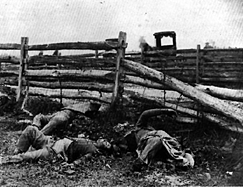
The American Civil War was fought--and documented--under completely different circumstances. Most of the Civil War photographers were independent entrepreneurs, whose success depended on sales. Their decisions regarding what and how to photograph were guided by the interests of the public, and not the interests of the government. They had no compunctions about showing dead bodies, and did so whenever it was possible.
It was not always possible. For one thing, photographers could not work in battle conditions. The equipment was too bulky, the materials--and the process--too slow. The solution was to record the results of battles rather than the battles themselves. Though casualties were desirable subjects, they were not always accessible. Because of the difficulties of communication, and the slowness of transportation, it could take several days for a photographer to learn of a battle and then get to the scene. More often than not, the bodies had already been buried by the time the photographer arrived. If the earliest Civil War photographs do not depict bodies, it was only due to circumstance--they were depicted as soon as conditions allowed.
The first significant occasion on which this occurred was in September 1862, after the massive battle at Antietam Creek, near Sharpsburg, Maryland. The photographers, Alexander Gardner and James Gibson, were able to reach the battlefield not long after the fighting ended (possibly even before), and to make seventy photographs within five days, all but eight of them in stereo format--the least expensive and most popular type of photograph.39 Nearly a third of the photographs show corpses.
The battle of Antietam has been called the bloodiest event in American history. Nearly six thousand soldiers were killed, more than seventeen thousand wounded, and another three thousand captured or missing. More than twice as many people died during the single day of the battle than in the entirety of the War of 1812, the Mexican War, and the Spanish-American War combined.40 As a major Union victory, Antietam was of considerable strategic importance. It also led directly to the issuing of the Emancipation Proclamation, which changed the nature of the war by making slavery the central issue. Antietam is also significant for being the first occasion on which the American public was to view its war dead.41
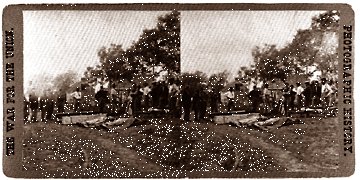
A sense of the reaction can be gained by consulting the public record. Some of the Antietam photographs were exhibited in New York City within a month after the battle. An anonymous writer for the New York Times provides the following description:
Of all objects of horror one would think the battle-field should stand preeminent, that it should bear the palm of repulsiveness. But on the contrary, there is a terrible fascination about it that draws one near these pictures, and makes him loth to leave them. You will see hushed, reverend groups standing around these weird copies of carnage, bending down to look in the pale faces of the dead, chained by the strange spell that dwells in dead men's eyes. It seems somewhat singular that the same sun that looked down on the face of the slain, blistering them, blotting out from the bodies all semblances to humanity, and hastening corruption, should have thus caught their features upon canvas and given them perpetuity for ever. But so it is.42
The contradiction between repulsion and "terrible fascination" is only the first that the writer articulates. Another, more troublesome paradox is not resolvable except by the employment of transcendental imagery. Referring specifically, again, to the photographs of bodies, he says:
But there is a poetry in the scene that no green fields or smiling landscapes can possess. Here lie men who have not hesitated to seal and stamp their convictions with their blood,--men who have flung themselves into the great gulf of the unknown to teach the world that there are truths dearer than life, wrongs and shames more to be dreaded than death. And if there be on earth one spot where the grass will grow greener than on another when the next Summer comes, where the leaves of Autumn will drop more lightly when they fall like a benediction upon a work completed and a promise fulfilled, it is these soldiers' graves.43
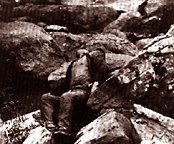
While the ignobility of death is conveyed with ruthless accuracy by these photographs, the nobility of dying for a cause must be searched for. The poetry that the writer finds in the scene is only discovered in his imagination. Furthermore, he must imagine a different scene than the one depicted. The bodies he sees must be tucked out of sight, literally buried in their graves, before his perplexities can also be laid to rest.
A similar quandary can be observed in the reaction to the Antietam photographs of a more sophisticated observer. Oliver Wendell Holmes, who addressed a national audience from the pages of the Atlantic Monthly, wrote about the experience of seeing these pictures some eight months after the article by the New York Times writer. Holmes had a son who had been wounded at Antietam, and had gone there in search of him. His viewing of the photographs was thus a re-viewing:
Many people would not look through this series. Many, having seen it and dreamed of its horrors, would lock it up in some secret drawer, that it might not thrill or revolt those whose soul sickens at such sights. It was so nearly like visiting the battlefield to look over these views, that all the emotions excited by the actual sight of the stained and sordid scene, strewed with rags and wrecks, came back to us, and we buried them in the recesses of our cabinet as we would have buried the mutilated remains of the dead they too vividly represented.44
Holmes is torn between the urge to look at the pictures and the urge to hide them away. His conflict is precisely the same as that of the Times writer, though his expression of it is far more evocative. The post-Freudian reader can hardly fail to notice that the burying of a "stained and sordid scene" in the "recesses of our cabinet" is a precise description of the repression within the unconscious of the primal scene.45 Troubled by the violent emotions kindled within him by the sight of the battlefield, and now rekindled by the photographs, Holmes seeks to bury them. He shares this reaction with the Times writer, along with the compulsion to reconcile what he calls the "repulsive, brutal, sickening, hideous thing" of war with the necessity to fight it:
The end to be attained justifies the means, we are willing to believe; but the sight of these pictures is a commentary on civilization such as a savage might well triumph to show its missionaries. Yet through such martyrdom must come our redemption. War is the surgery of crime. Bad as it is in itself, it always implies that something worse has gone before. Where is the American, worthy of his privileges, who does not now recognize the fact, if never until now, that the disease of our nation was organic, not functional, calling for the knife, and not for washes and anodynes?46
For both writers, the dead men in the Antietam photographs are martyrs. For Holmes, however, the soldiers are holy martyrs, even redeemers. For the Times writer, the photographs are honorific images, while for Holmes they are consecrated, iconic. However, this difference between the writers is principally one of degree. Just as Holmes' repulsion (and probably his attraction) is stronger than that of his colleague, so is the vehemence of his effort to overcome it, and the language he uses to express it.
There is one respect in which the two writers unquestionably differ: Holmes had viewed Antietam at first hand, while the Times writer had not. This distinction is nevertheless of little consequence, since the nature of their response (if not the degree) is the same. It does not seem to matter whether the photographs provide a new experience or the memory of an earlier one. For both observers, the images actualize the things they depict.
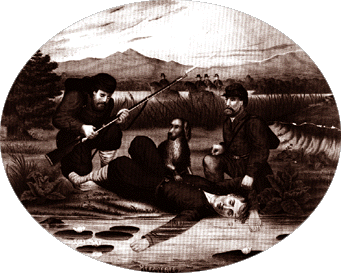
In this, the photographs of Antietam and other battle sites contrast sharply with the woodcut reproductions of artists' field sketches reproduced in the illustrated newspapers of the period, and even more sharply with the lithographs and other prints created for the mass market. The woodcuts in such publications as Harper's Weekly and Frank Leslie's Illustrated Newspaper were principally views of battles, though a smaller percentage depicted life in the army camps.47 Though all of these pictures made necessary claims to journalistic accuracy, the battle scenes nevertheless emphasized action and drama. This too was by necessity, since exciting pictures sold newspapers, as much then as now. The popular prints of the era, on the other hand, were meant for the parlor wall rather than the breakfast table, and were designed to be more appealing than accurate. Those few which depict casualties do so in an extremely sanitized fashion. War, as seen in these prints, is not brutal or violent. The dead soldiers are hardly bruised, or even dirty.
In these pictures, the discrepancy between the ignominy of death and the loftiness of its cause has been eliminated. Though the reassurance this provides is completely absent from the photographs of similar subjects, there is evidence that the fascination felt by Oliver Wendell Holmes and his New York Times colleague was shared by the general public. The Times writer, for instance, mentions that "Crowds of people are constantly going up the stairs" to the gallery exhibiting the Antietam pictures. While this statement may contain a measure of hyperbole, there is evidence that the stereographs from the Antietam series sold well, at least for the following three years.48 It is fair to presume that the response of the public corresponded to that of the writers in other respects as well, and that the pattern of denial and acceptance was commonly shared. These public postmortem photographs, like the private ones, compelled their viewers to confront the actuality of death.